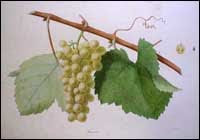A trip on the track of the old grape variety Furmint can really wear out the wikipedias these days—where once upon a time various libraries would be consulted, dusty tomes wiped sneezily off, and faxes fired away in the directions of Klosterneuburg and Geisenheim and Montpellier and Davis, beseeching council and elucidation, one now just employs search engines in any familiar language to be rewarded with a dazzling array of conflicting information, along with attractive images that are (we hope) in the Public Domain.
This much we suspect: it could derive the name from its wheaten color—the French word froment offers an alternative to blé. Or perhaps the name comes from the Italian city Formia, or might have been blessed by the Venetian princess Formentini in the 17th century. Or perhaps the great poet Goethe is correct, and Furmint originated in Croatia.
Two known facts are:
1. Acidity
2. Alcohol
—facts that become factors facing the intrepid vintner who wishes to tame this tiger into something fit for other than long-living and multifaceted desserts.
Mr F is not too choosy so far as the dirt in which he stands, and bears abundant fruit, although not with any regular pattern. He rises early, but shines only late—for example, in Hungary most frequently picked at the end of October—a well-bred resistance to gray rot makes this possible, though he is occasionally irritated by oïdium...
Furmint has provided the backbone of the great Tokaji Aszu of Hungary since time immemorial, blended with the Hárslevelű and a number of other only slightly more pronouncable possibilities.
Since 1987, Furmint’s cultivation for dry wine has been permitted in Rust, but the name doesn’t currently appear on Wein Burgenland’s page of white varieties.
As a dry wine, we find that Furmint offers distinct varieties of expression: two recent visits to the newly anointed Michelin One-StarSeäsonal in W. 58th St. spelled the end for bottles of Heidi Schröck’s very tasty and tightly focused 07er Furmint—once where it served as an attractive companion to several successive courses, and the second visit when it prepared the palates of Winemongers James and Stephan for delights to follow, along with those of friendly competitor Carlo Huber and ÖWM-boss Willi Klinger.
But it still remains somewhat of a specialty: in addition to the aforementioned Heidi and fellow Ruster Michael Wenzel, a recent quick read through the Falstaff Weinguide turned up only two more rating-worthy Furmints out of 48 growers in Neusiedlersee Hügelland.
Wenzel, in particular, seems to explore the aromatic possibilities of the variety to the utmost, while keeping alcohol in check and balancing acid with texture rather handily.
And then there are the sweet expressions of Furmint—one in particular needs little introduction, or does it? The Ausbruch of the Free City of Rust: it's not about varietal character, but rather the blessing of the botrytis mold which affects the grapes with nearly yearly regularity. There are many inventive cuvées made, but one of the most traditional combines Furmint with the Gelber Muskateller.
And herewith, a catalog of Furmint's many aliases—not every one merits its own picture on the post-office wall, but some will be known to you ~:~
Allgemeiner, Alte Sestrebe, Arany Furmint, Beregi Furmint, Bieli Moslavac, Biharboros, Bihari Boros, Bihari Boros, Budai Goher, Cimigera, Csapfner, Csillagviraga Furmint, Damzemy, Demjen, Domjen, Edelweißer Tokayer, Edler weißer Furmint, Féher Furmint, Formint, Formont, Fourminte, Furmint bianco, Furmint de Minis, Furmint Féher, Furmint Szagos, Furmint Valtozo, Gelber Moster, Gemeiner, Görgeny, Görin, Goher Féher, Gorin, Grasa de Kotnar, Holyagos Furmint, Jardanszki Furmint, Keknyelü, Keresztesevelu Furmint, Kiraly Furmint, Krhkopetec, Ligetes Furmint, Luttenberger, Madarkas Furmint, Mainak, Maljak, Malmsey, Malnik, Malvasia verde, Malvoisie verte, malzak, Mehlweiss, Moscavac bijeli, Moslavac, Moslavac bijeli, Moslavac zuti, Moslavina, Mosler, Mosler gelb, Mosler gelber, Moslertraube, Moslovac, Moslovez, Nemes Furmint, Poam Grasa, Poma Grasa, Poshipon, Pošip, Pošipbijeli, Pošipveliki, Pošip Vrgonski, Posipel, Posipon, Pospisel, Rongyos Furmint, Salver, Sari Furmint, Sauvignon Vert, Schimiger, Schmiger, Seestock, Seeweinrebe, Shipo, Shipon, Shiponski, Sipelj, Šipon , Som, Som shipo, Somszölö, Szala, Szalai, Szalai janos, Szalay Göreny, Szegszolo, Szegzölö, Szigethy Szöllö, Szigeti, Toca, Toca Tokai, Tokai Krupnyi, Tokaiskii, Tokaisky, Tokaijer, Tokay, Tokayer, Ungarische, Weisslabler, Weisslauber, Zapfete, Zapfner and Zilavka


